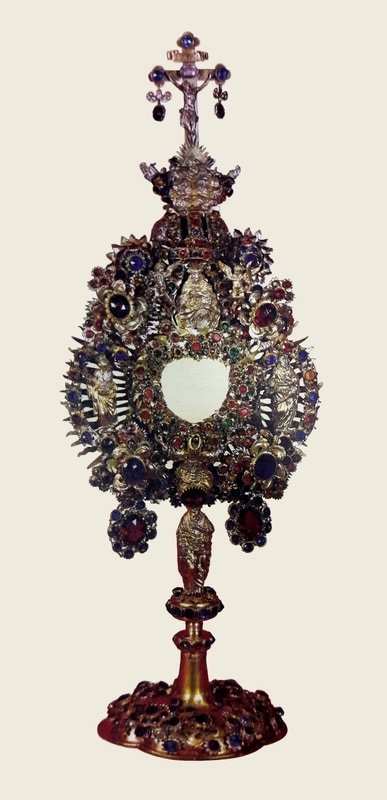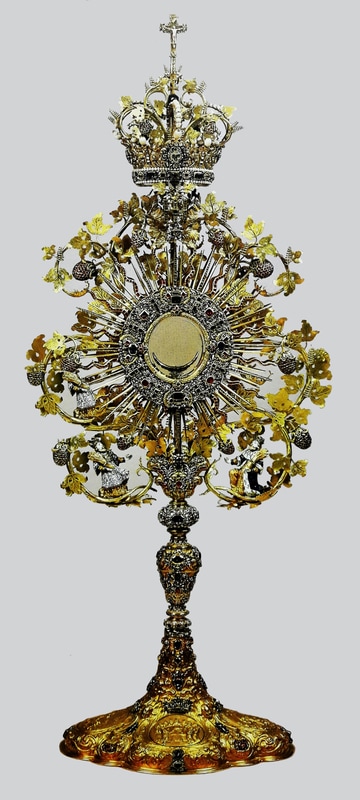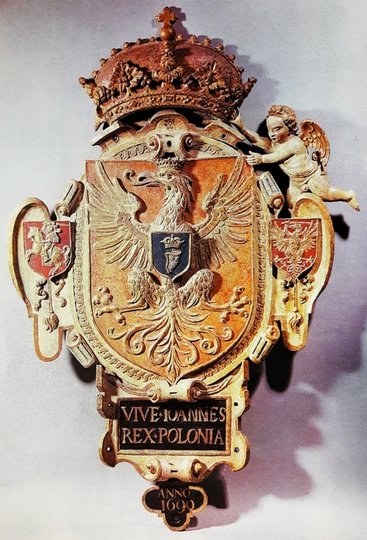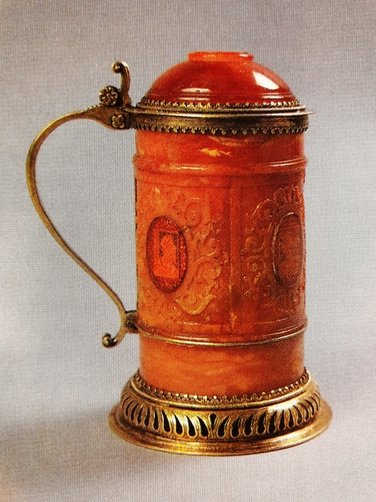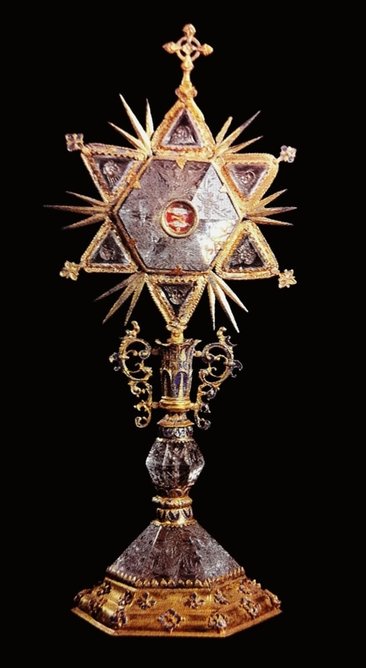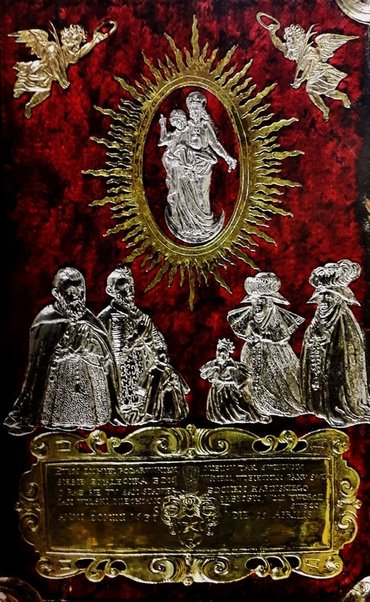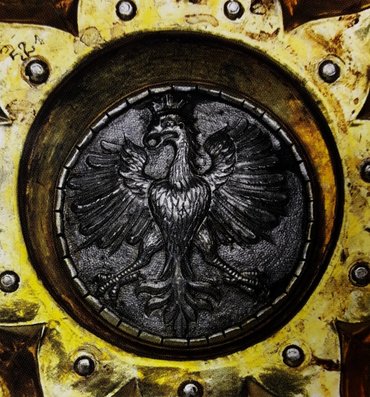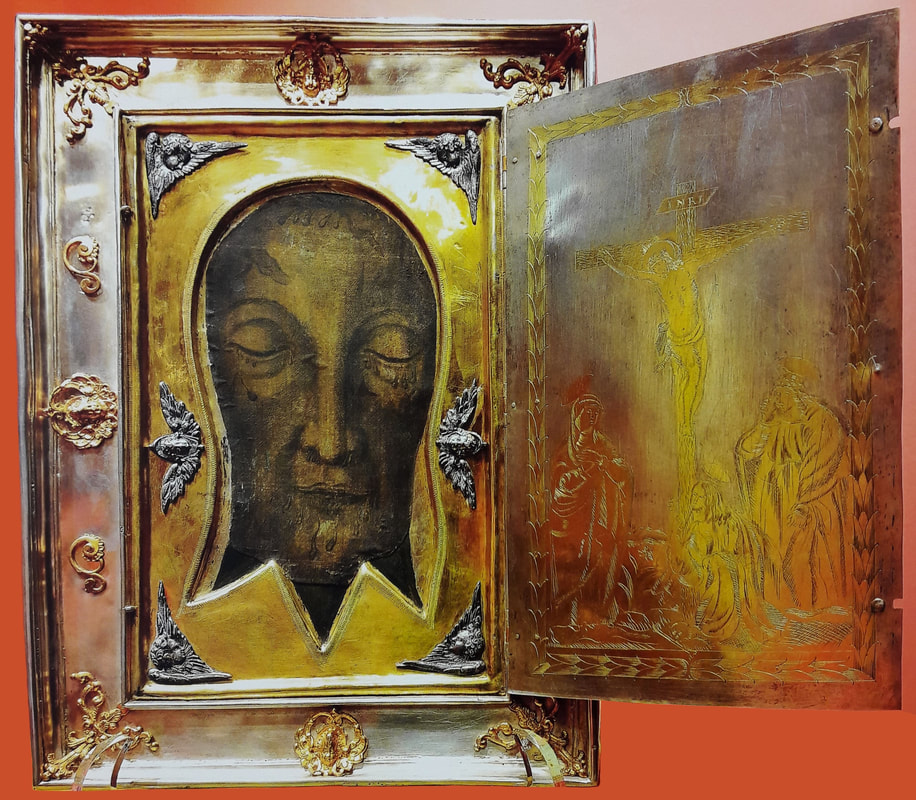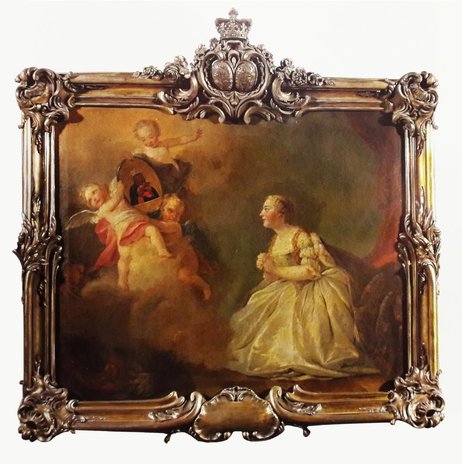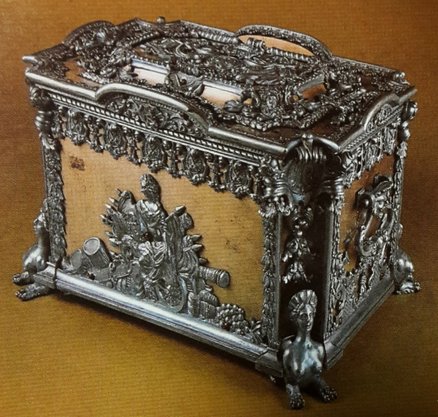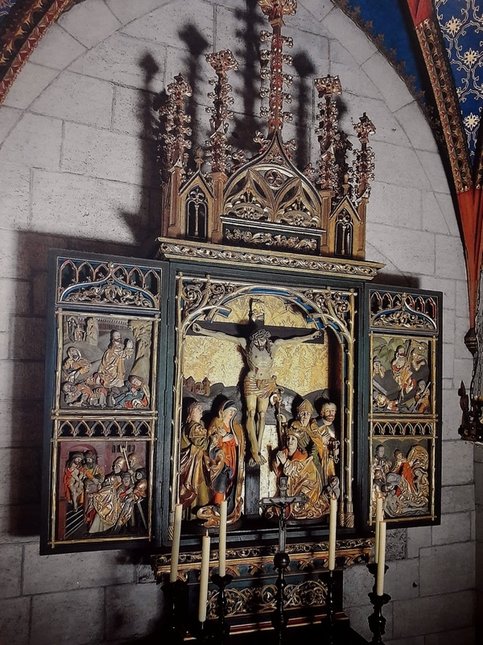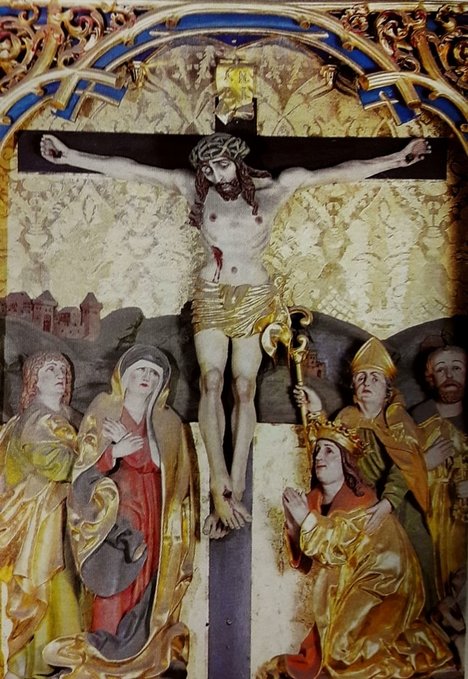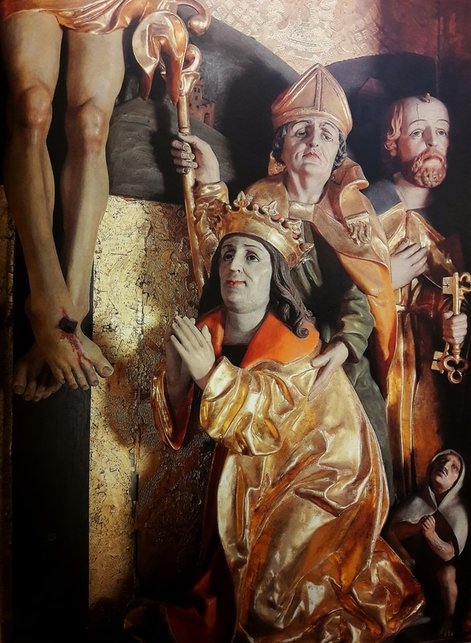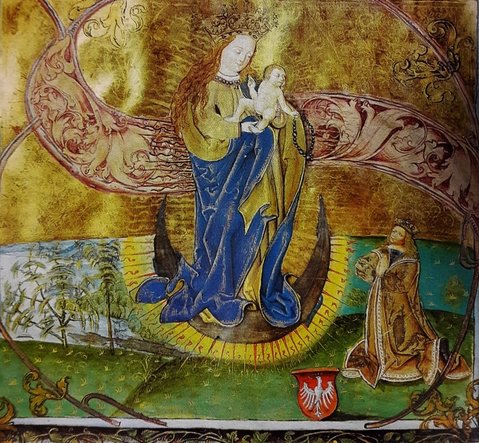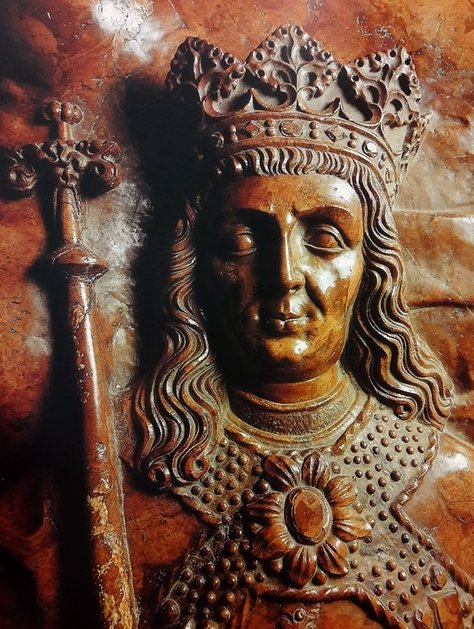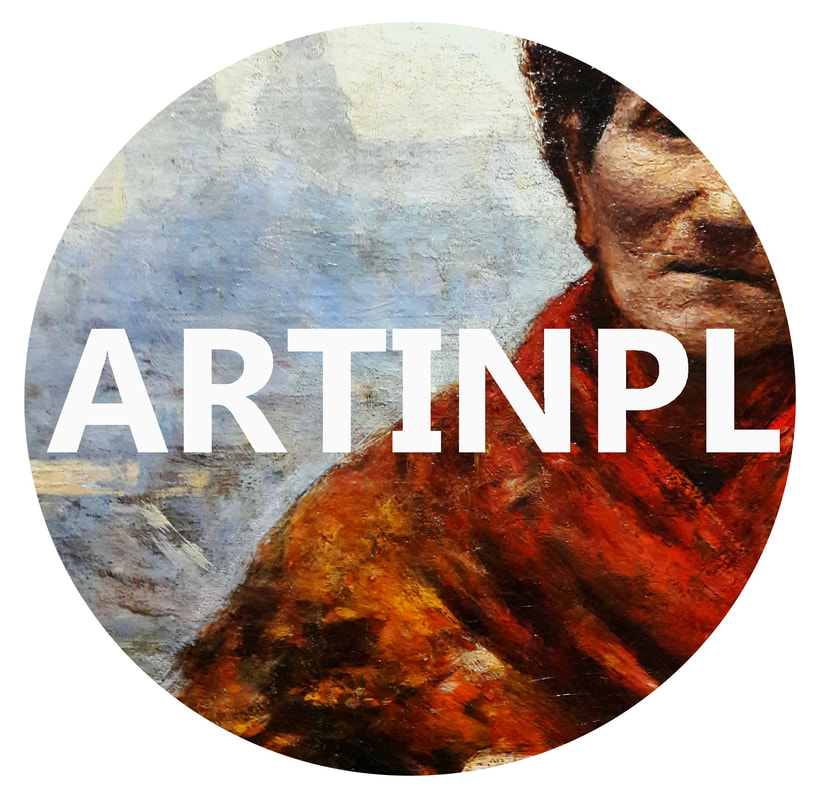|
The richly decorated 17th-century monstrance of Bishop Stanisław Kazimierz Dąmbski's foundation, is used exclusively for displaying the Blessed Sacrament on Good Friday and during the solemn procession of the Resurrection on Holy Saturday. It was created between 1680 and 1699 possibly by a Silesian goldsmith Christian Schrötter in Kamienna Góra. Made in silver and adorned with semi-precious stones, it represents Christ in the form of a Host, accompanied by figures from the Old (Abraham, Melchizedek) and New Testament (Mother of God, St. Joseph, St. Peter). It was bequeathed to the Wawel Cathedral by the founder as an equivalent for the gold chalice and silver sanctuary lamp offered traditionally by the bishops at their inauguration.
Bishop Stanisław Dąmbski's monstrance by Christian Schrötter in Kamienna Góra, 1680-1699, Cathedral Museum at Wawel Hill in Kraków.
The monstrance, a chief example of the 17th century Polish goldsmithery, was commissioned by Augustyn Kordecki, Abbot of the Jasna Góra Monastery and later Provincial of the Pauline Fathers, as an ex-voto for the defence of the monastery during the invasion of the Polish-Lithuanian Commonwealth by the neighbouring nations in 1655, so-called Deluge. It was created in 1672 in Warsaw by Royal goldsmith Wacław Grotko from Prague in Czechia (also known as Grottke or Grottkau, active in Warsaw between 1665 and 1675), who was paid 30,000 zlotys in gold.
The work was made from jewels donated by pilgrims to the monastery. Over one meter high (103 cm) and over 13 kg weight monstrance was adorned with 2.366 diamonds, 2.208 rubies, 30 saphires, 81 emeralds, 215 pearls and enamel. A large diamond set in the crown at the top, was bequeathed to the monastery by Zygmunt Przerembski, voivode of Sieradz in 1668. Prophet Aaron and King David kneeling at both sides of the glory are holding wheat sheaves, an eucharistic symbol. Scenes at the foot of the monstrance are related to two themes: the sacrifice of Christ (the Sacrifice of Abraham and the Passover) and the eucharist (Elijah in the Desert and the Last Supper). According to inscription on the base of the monstrance, Father Augustyn Kordecki was Provincial, Father Stanisław Ligęza was Abbot of the Jasna Góra Monastery and Father Romuald Dymalski was Sacristan of the monastery at the time of its creation.
Abbot Augustyn Kordecki's monstrance by Wacław Grotko in Warsaw, 1672, Treasury of the Jasna Góra Monastery.
Main centers of craftsmanship in the Polish-Lithuanian Commonwealth (PLC) in the late 16th and at the beginning of the 17th century, a period dominated by late Renaissance forms in arts, were large cities like Gdańsk, Poznań, Vilnius, Lviv and Kraków. Although now perceived as former German territory, Königsberg, known in Polish as Królewiec, was at that time the capital of Duchy of Prussia, a fief of the Crown of Poland, hence part of the Commonwealth and one of the country's important production and trade centers. Amber crafts developed therein, can be therefore considered as integral part of the PLC's production. Mannerist forms in applied arts prevailed till mid-17th century.
Carouche with coat of arms of the Polish-Lithuanian Commonwealth by Anonymous from Gdańsk, 1612, Artus Court in Gdańsk. Modified in 1690 to honour John III Sobieski.
Amber tankard in silver frame by Anonymous from Königsberg, ca. 1610, Czartoryski Museum.
Rock crystal reliquary in silver frame by Anonymous from Kraków, beginning of the 17th century, Mogiła Abbey.
Silver votive plaque with velvet background of Jan Wolski by Anonymous from Poland, 1631, Treasury of the Jasna Góra Monastery.
Polish Eagle, fragment of silver goblet with Saint Catherine by Anonymous from Kraków, first quarter of the 17th century, Kremlin Museum.
Vera icon of Constance of Austria in a silver-gilt frame founded by Primate Jan Wężyk by Anonymous from Poland, 1630s, Diocesan Museum in Łowicz.
Maria Josepha of Saxony visited the Jasna Góra Monastery with her sister Maria Anna Sophia on May 23rd, 1744. Daughters of Augustus III of Poland and Saxony offered to the Black Madonna of Częstochowa two gold hearts with their names as votive offering. In 1747 the princess married Louis, Dauphin of France (1729-1765) and some time later, in 1756, through intermediary of Duchess Jabłonowska, she sent to Jasna Góra a votive offering for healing her husband. The oil on canvas painting by anonymous French painter is set in a rich bronze frame, cast, chased and gilded, adorned with rocaille motifs and cartouches with coat of arms of Maria Josepha (Polish-Lituanian Commonweath and Kingdom of France). Inscription on frame informs about the intentions of the Dauphine of France. Both the painting and frame were creted by French workshop. Similar example of craftmanship is a late baroque strongbox with monogram of Augustus II of Poland by Pierre Fromery.
Votive painting of Maria Josepha of Saxony by Anonymous from France, ca. 1753, Treasury of the Jasna Góra Monastery.
Strongbox with monogram of Augustus II the Strong by Pierre Fromery, 1697-1733, Czartoryski Museum.
The reign of king John Albert was a period of gradual transition from gothic to renaissance art in Poland. Majority of preserved effigies of the king were most probably created posthumously, however the artists who worked for the Wawel Cathedral, beyond any doubt known the king personally.
Among the oldest is a portrait of the king as a donor kneeling before the crucified Christ in a group of sculptures known as the Triptych of John Albert. The triptych was commissioned to the king's funeral chapel and created by Stanisław Stwosz (Stanislaus Stoss) in 1501. This original retable was dismanteled in about 1758 and some elements were reused in a new altar for the Czartoryski Chapel of the Cathedral between 1873 and 1884. Similar grafic effigy of the king was included in a graduale, a book collecting all the musical items of the Mass, which he founded in 1499 for the Cathedral. John Albert was depicted once again as donor, kneeling before the Apocalyptic Virgin in a miniature by Master Maciej z Drohiczyna (1484-1528). The last of the effigies, and the most important, is the king's tomb effigy carved in red marble by Jörg Huber. Late gothic image of the king lying in state with all attributes of his power was crowned between 1502 and 1505 with a renaissance arch created by Francesco Fiorentino. The tomb was founded after king's death by his mother Elizabeth of Austria and his youngest brother Sigismund.
Altar from John Albert Chapel now in the Chartoryski Chapel of the Wawel Cathedral with original sculptures from the early 16th century, in the casing from the third quarter of the 19th century by Władysław Brzostowski.
Crucifixion with king John Albert as donor by Stanisław Stwosz, 1501, Chartoryski Chapel of the Wawel Cathedral.
Crucifixion with king John Albert as donor by Stanisław Stwosz, 1501, Chartoryski Chapel of the Wawel Cathedral.
Miniature in graduale of king John Albert by Master Maciej z Drohiczyna, 1499-1501, Archives of the Wawel Metropolitan Chapter in Kraków.
Tombstone of king John Albert by Jörg Huber, ca. 1502, John Albert Chapel of the Wawel Cathedral.
|
Artinpl is individual, educational project to share knowledge about works of art nowadays and in the past in Poland.
If you like this project, please support it with any amount so it could develop. © Marcin Latka Categories
All
Archives
April 2023
|
